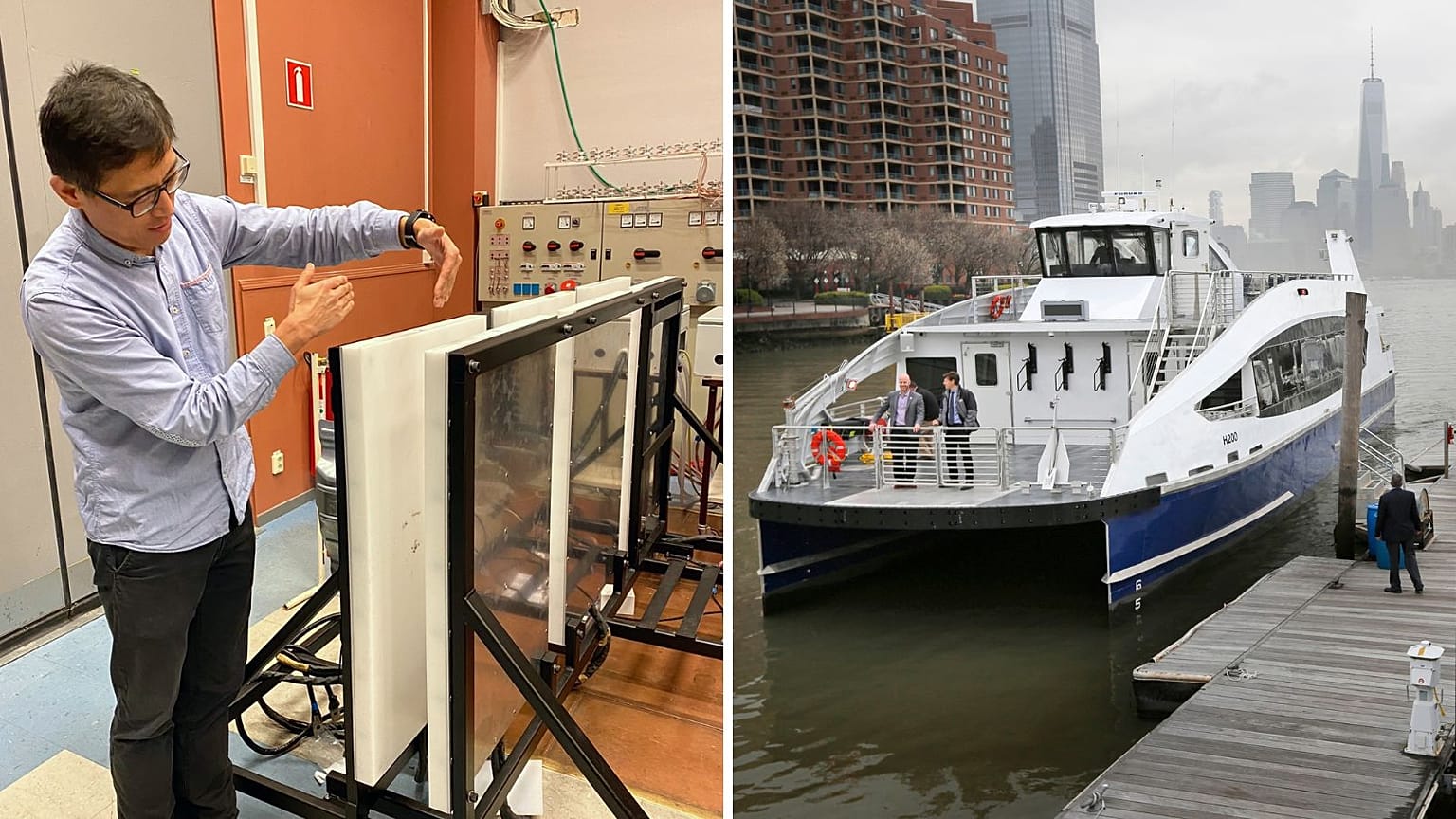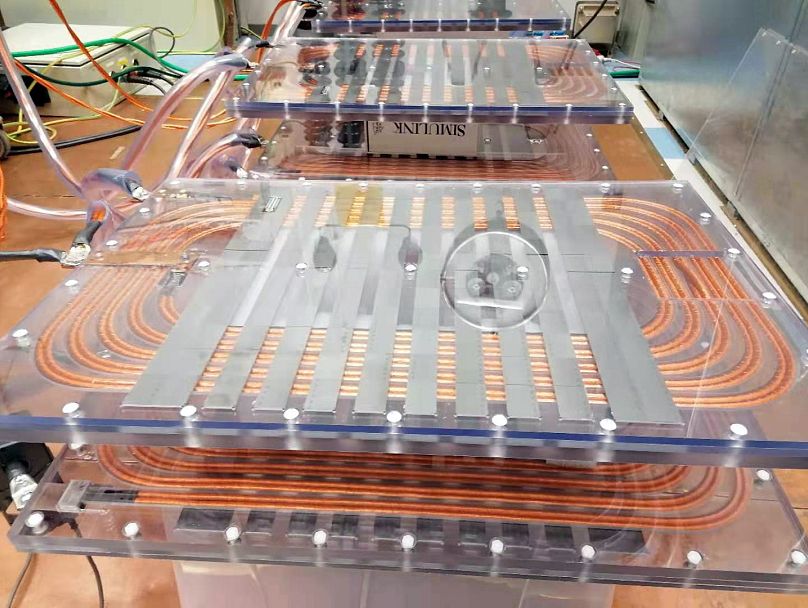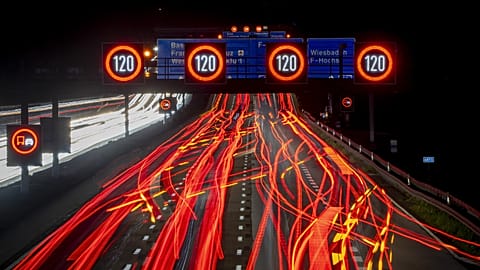Copper wires as thin as human hair are helping to make inductive charging a reality, with no humans or robot arms needed.
Electric ferries and vehicles could soon be charged wirelessly after an exciting technological breakthrough.
Until now, inductive charging - where there’s no contact between the device and conductor - has been unable to deliver the high power that electric vehicle batteries need. The method has only worked for small devices, like electric toothbrushes and some mobile phones.
But new components have enabled scientists at a Swedish university to show that the recharging of urban ferries and city buses is possible without human or robotic hands.
It’s a vital step for the electrification of our transport systems, says the man who has put the pieces together.
“You can have a system built into the wharf that charges the ferry at some stops while passengers get on and off,” explains Professor Liu, professor of electric power engineering at Chalmers University of Technology in Gothenburg.
“Automatic and completely independent of weather and wind, charging can take place 30-40 times per day.”
This is the most obvious application Liu sees for the inductive power transfer technology, which would help to speed up the phasing out of polluting diesel boats.
What are the new components behind the breakthrough?
A copper wire as thin as a human hair is one of the new materials that makes transmitting high power through air a realistic proposition.
The other is a new type of silicon carbide semiconductor. Silicon has long been used in electrical devices (like computer chips) due to its naturally semiconducting properties; with a higher electrical resistance than an insulator, but less than a conductor, the non-metal element controls the current by allowing electrons to flow when a particular voltage is applied.
Silicon carbide is a compound where carbon is bound to the silicon. As a power source for electrical products, it's only been on the market for a few years, explains Liu.
“A key factor is that we now have access to high-power semiconductors based on silicon carbide, known as ‘SiC components’,” he says. “They allow us to use higher voltages, higher temperatures and much higher switching frequencies, compared to traditional silicon-based components.”
How does induction charging work?
To understand what this has got to do with boosting an electric bus or ferry, we need to grasp the basics of induction charging.
Charging by induction means that the current can hop across a short distance; through air, water, and other non-metallic materials - without any contact or a conductor.
Our homes are full of examples. In induction cookers, a high-frequency alternating current passes through a metal coil to produce an oscillating magnetic field. This penetrates the metal of a cooking pan, inducing a current in it that heats your food up.
Or head to the bathroom; electric toothbrushes have one coil in their bottom and a second in the charging base. When plugged into the mains, the current inside the charging coil creates a changing magnetic field that makes a current flow inside the toothbrush coil without the two touching.
For charging electric vehicles, the aim isn’t heat development (or making your teeth shiny). Inductive charging sends energy to the coil on board the vehicle via the magnetic field. The coil converts it into alternating current, then back into direct current to recharge the batteries.
Why is wireless charging of big electric vehicles now possible?
The fact that SiC components can operate at higher frequencies is key, because it’s the frequency of the magnetic field that limits how much power can be transferred between two coils of a given size.
“Previous systems for vehicle wireless charging have used frequencies of around 20 kHz, much like a normal stove top. They became bulky and the energy transfer wasn’t very efficient. Now we work with frequencies that are four times higher. Suddenly, induction becomes attractive”, explains Liu.
But the copper wires in the coils have to be able to send and receive the magnetic field at a higher frequency too.
“That won’t work with ordinary looped copper coils. It would lead to very large losses at high frequency”, says Liu.
The new coils are made of braided “copper ropes”. These comprise up to 10,000 copper fibres, each between 70 and 100 microns thick, much like a strand of hair. Known as ‘Litz wires’, these braids - optimised for higher currents and frequencies - have also been commercially available in the last few years.
Whether electric vehicles are charged using inductive charging or ordinary cable-based conductive charging, energy losses are bound to occur.
But the breakthrough with these new materials means that the inductive method is now almost as efficient as regular charging. “The difference is so small as to be practically negligible,” says Liu, “It’s about one or two per cent”.
Will electric cars be charged wirelessly too?
As well as electric ferries and buses, driverless electric vehicles used in industry, mining and agriculture could benefit from wireless charging in the future.
Liu doesn’t think that induction charging will eventually replace charging with a cable, though.
“I drive an electric car myself and can’t see that I’d have any use for induction charging in the future. I drive home, plug in... it’s no problem”.
“One probably shouldn’t claim that the technology itself is more sustainable,” he says. But it can make things easier when electrifying large vehicles and thus speed up the phase-out of things like diesel ferries.
The results from his research group have attracted a lot of attention, he adds, as they’re among “the best in the world” at this power class.



















